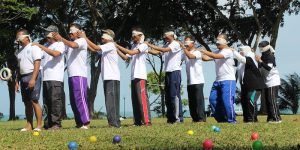

As humans, we are social creatures with personal histories based on the various groups that make up our lives.
Childhood begins with a family of origin group and then progresses to groups for education, social activities, shared interests/hobbies, and work.
Group therapy can be traced back to Joseph Pratt. In 1905 he was teaching education classes on hygiene for patients struggling with tuberculosis (Pratt, 1907). Pratt noticed that patients who regularly attended presentations and interacted in groups afterward remained optimistic and courageous and had fewer symptoms and better recovery than those who did not.
Pratt (1907) believed that the emotional connection and support led to increased hope and physical improvement.
Group therapy activities provide emotional connection, education, support, encouragement, and guidance that can improve mental, emotional, and physical wellbeing. In this article, we will list various group therapy activities to use in your practice.
Before you continue, we thought you might like to download our three Positive Psychology Exercises for free. These science-based exercises explore fundamental aspects of positive psychology, including strengths, values, and self-compassion, and will give you the tools to enhance the wellbeing of your clients, students, or employees.
There are several factors that should be considered as a therapist or leader begins to perform activities in group therapy. A needs assessment is essential to determine the purpose of the group and the specific activities, format, and structure that will follow.
Is this group open or closed? Is it designed to treat specific conditions or ailments such as post-traumatic stress disorder, addiction, or a specific mental health issue? Who makes up the group regarding age, gender, race, religion, etc.?
A pre-group orientation is helpful to identify individual patterns of group members and their history of interpersonal relationships (Whittingham, 2018).
The initial orientation will help build a positive emotional bond and working alliance with and among clients. Informing clients about the nature of group therapy and reviewing group agreements, logistical information, and assumptions can help group members feel safe, connected, and more engaged in group activities (Whittingham, 2018).

Warm-up activities in group sessions help clients build connections, reduce anxiety and defensiveness, and can shift focus to specific topics of discussion.
These activities can be used for nearly any age group and for any specific purpose.
In this activity, clients will each get an index card to write down three things about themselves. Two of them are true, and one is a lie. Members will go around the room stating the three pieces of information, and other members of the group must guess the lie.
Members of the group will each get an index card with a topic on it (any random topic will do). Individuals talk about the topic for one minute. This fun activity allows members to open up, get creative, and express ideas and opinions about specific topics.
Ask clients to think about being trapped on a desert island. They may bring one luxury item, one entertainment item, and one survival item. Have members share what they would take with them. This is often a revealing activity that can help members get to know one another.

Enhance wellbeing with these free, science-based exercises that draw on the latest insights from positive psychology.
Download PDF
By filling out your name and email address below.
There are many activities to incorporate into group therapy for adults.
The activities should reflect the goals and composition of group members as well as the theoretical approach used by the group leader or therapist.
Narrative group therapy is an existential approach to therapy and allows clients to take ownership of their story by sharing it and rewriting it (Clark, 2014).
It provides space between an individual and their lived experience so they can separate problems from their life. Some narrative therapy activities that can be done in group settings include:
Clients are asked to identify five to 10 chapter titles for their life and briefly explain each. They can share these stories with other group members, which helps reinforce the idea that the past is in the past and the future is an opportunity for new beginnings.
A statement of position map is an opportunity for clients to identify a problem, map out the effects of the problem across all areas of their life, and explore how the impacts of this problem deeply affect them.
As clients do this individually, they can share the effects of the problem with group members, which offers support and validation.
Expressive art storytelling can be made into a group activity by having members take part in expressive art together. An example would be to have group members individually draw or paint to the sound of music in a way that depicts their personal story for a specified amount of time. After the session, clients share the meaning of their art with other group members.

According to the Kaiser Family Foundation, an independent source for health policy research, approximately one-third of US adults struggle with anxiety and depression.
Group therapy can provide a supportive and cost-effective way to treat symptoms and underlying causes of these debilitating mental health conditions.
This is an effective group activity for both anxiety and depression once a (closed) group has been a cohesive unit for several weekly sessions. It is important for group members to know one another to some degree.
A sheet of paper is passed out to each member, and they will write their name on the sheet. The paper is passed around so that other members can write positive affirmations directed to the member. This activity can be uplifting for individuals struggling with depression and decrease levels of anxiety.
This activity is based on Cognitive-Behavioral Therapy (CBT), behavioral activation, and goal setting. Each member of the group writes down a goal they would like to accomplish to improve mental health, such as diet, exercise, sleep, mindfulness, etc.
Members write down as many goals as they would like and pass the ideas around. Once the list is complete, the group can brainstorm practical ways to implement behaviors that will help achieve these goals.
This positive thought replacement worksheet is based on CBT and can be used in a group setting. Each member can write down or identify a negative automatic thought they typically have. The member sitting next to them will come up with a positive replacement thought.
Thought identification and replacement is a cornerstone of CBT, which is an evidence-based treatment for both anxiety and depression (Wolgensinger, 2015).
This video expands on how useful group therapy can be for anxiety and depression.